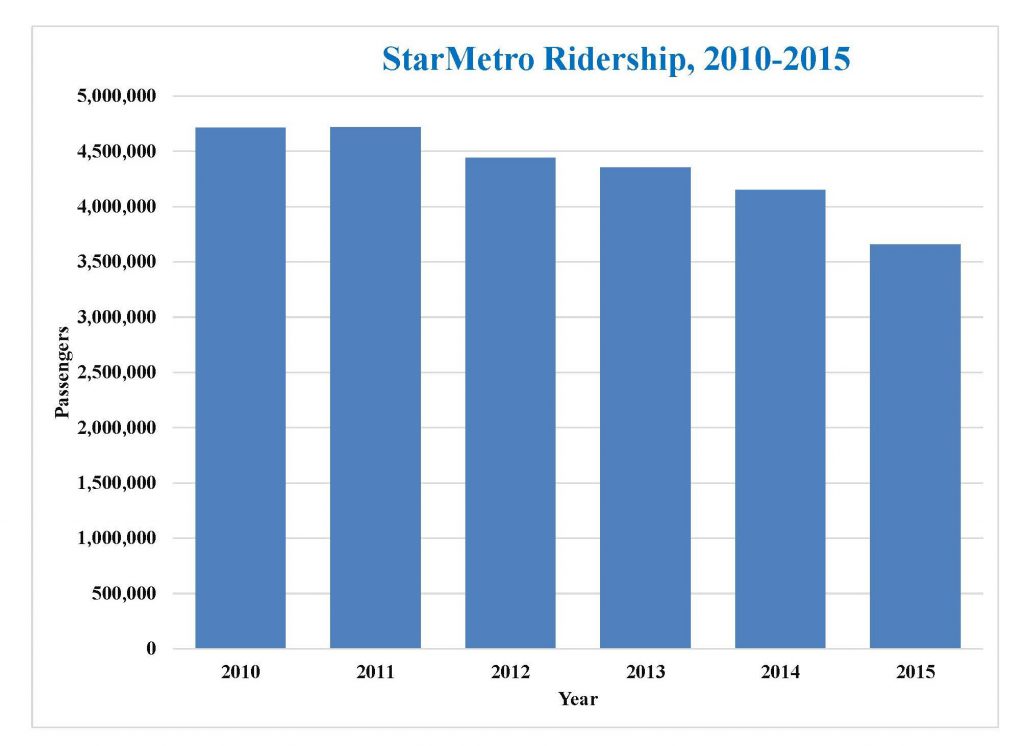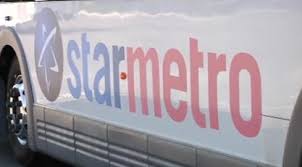Tallahassee Reports, through a public records request, has determined that StarMetro ridership has declined 22% from 2010-2015. During this same time period the subsidies provided to StarMetro by City of Tallahassee taxpayers has increased by 27%.
Ridership was down from 4.71 million people in 2010 to 3.66 million in 2015. These ridership numbers include both City passengers and University passengers. Both categories declined during the five-year period. University riders declined 17% while City passengers declined 27%.
Also, due to the recent cancellation of the FAMU contract with StarMetro to provide bus services on campus, passenger numbers are expected to decline again in 2016.
During this same time period, the subsidies provided by taxpayers has increased from approximately $7.9 million in 2010 to approximately $10 million in 2015.
The subsidies are transferred annually from the General Fund, which is supported by property taxes, sales taxes, and utility taxes.
Recently the City of Tallahassee began using revenues collected from the Gasoline Tax to fund StarMetro operations. Since 2014 approximately $2.3 million in Gas Tax revenue has been transferred to StarMetro.
This means over the last three years, approximately $6.9 million has been removed from road paving, road maintenance and sidewalk projects to support StarMetro.
Various citizens groups, who are actively engaged with evaluating the City’s spending priorities, have raised concerns about StarMetro’s role in the need for the recent property tax increase and the lack of concern by City staff with StarMetro’s operational efficiency.
The City will present the FY2017 budget on June 2oth. TR will report on how the City deals with StarMetro funding when the information becomes available.


Making starmetro a viable transportation alternative for all citizens ought to be a high priority. Public transportation as an alternative to the one person in a car driving that mostly happens is what will prevent traffic gridlock (that planners suggested the road through Killearn — now cancelled — to address).
Has it occurred to anyone to compare the percentage of people working now to five years ago— we have a number of work force drop outs. We don’t know if the cost of the rides (which is now more than it was then, and the difficulty of buying fare cards) might also be affecting ridership. But it is true that inconvenience is the single biggest reason that drivers drive instead of take a bus.
There is a lot more we ought to know before we argue against the subsidy.
I agree. The information is good, but there are are plenty of variables that need to be considered. Job market, gas prices, route changes, fare changes. Total City gas tax collections, not just the amounts transferred. Comparative data from years prior to 2010 – (pre recession?). Should the subsidy approximate a % of operating cost, or a hard $ cap…
Most of the times I’ve ridden, the bus has 5 or less passengers.
Inexcusable inefficiency.
There’s no bus service to the airport, why?
Answer: the taxi lobby.
Sure, gas prices are down, but so is the labor force participation rate.
This much I know:
If the minimum wage goes to $15/hour, the robots still won’t need bus passes.
Another example of our commissioners not doing their homework and just letting department heads and the city attorney and manager lead them by the nose. They justify their failure to exert more energy or to understand issues in depth by saying our city staff is excellent and we should give their guidance great deference. In other words, let the staff do the heavy lifting and I will pretty much vote they way they tell me. Ask an occasional question for the benefit of the voters, a rah rah, mom and apple pie question that more often than not just shows their lack of in depth comprehension of the issues. The city commission has become nothing more than a rubber stamp for staff advice, and a forum to run for another term or another office. The office of mayor is primarily a taxpayer funded springboard for party politics and national office. Incumbents always rely on the uninformed voter. Anyone currently serving in local, state or national office is part of the problem.
In Miami, Jitneys have been around for many years and supplement the Gov. Run Bus system. Lets also not forget Uber and other new methods that are in pipeline like self driving cars that could in theory work has taxis.
See Miami-Dade County link here about jitneys: http://www.miamidade.gov/licenses/jitneys.asp
More money down a rat hole.
IF WISHES WERE HORSES
BEGGARS WOULD RIDE.
Tallahassee has its priorities utterly backwards, as our recent top rating in crime statistics for a SECOND STRAIGHT YEAR unarguably demonstrates.
We should be additionally subsidizing the police and sheriffs’ departments by at least 27%, and cut subsidies for Star Metro by at least double or triple that figure. Then the money spent could actually make a difference in the community.
Why does StarMetro run such large buses? Why not smaller buses more often if they want folks to use the system; especially at peak hours.
If you have to wait two+ hours to get from point A to point B, how is this a service?
If you have to walk out of your way to get to a bus stop, why bother?
If you have to get up two hours early to catch a bus, why bother?
If we have to arrange our lives to Star Metro’s schedule, why bother?
What did the city expect after their “improved” routes eliminated so many stops with no reguard to users. And apparently brought about fewer riders w/o any cost savings in fuel, staff, etc.
Should the headline read plummets instead of pluments?
Yes. Thanks.